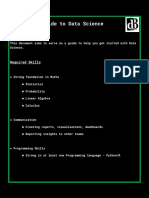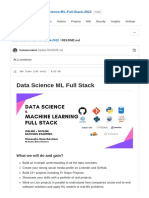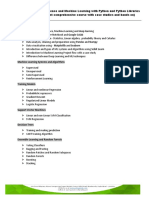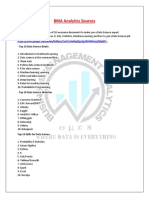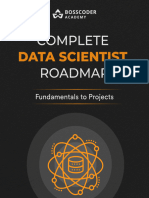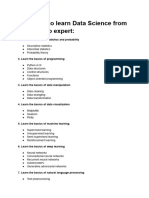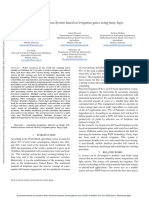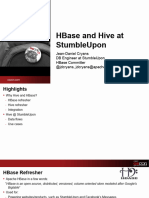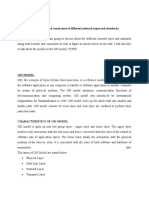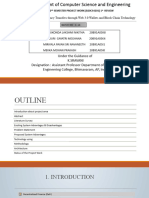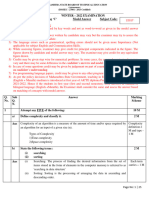Machine Learning Roadmap for Aspiring Data
Scientists
1. Foundational Topics
• Mathematics: Master linear algebra (vectors, matrices, eigenvalues), calculus (derivatives,
gradients), probability, and statistics (distributions, hypothesis testing). These are the quantitative
foundations behind ML algorithms. Resources include Khan Academy or MIT OpenCourseWare math
courses, and the book Mathematics for Machine Learning (Strang, et al.).
• Python Programming: Learn core Python (syntax, data types, functions, OOP). Practice using
Jupyter notebooks. Study libraries like NumPy and Pandas for data manipulation. The official Python
tutorial and books like Automate the Boring Stuff with Python are helpful. DataCamp or Coursera have
beginner Python courses tailored to data science.
• Data Analysis & Visualization: Use NumPy (arrays) and Pandas (DataFrames) for data wrangling.
Learn Matplotlib and Seaborn for plotting. For example, the NumPy documentation offers a
“Quickstart Tutorial” for beginners 1 . Practice exploring datasets: cleaning missing values,
summarizing statistics, plotting distributions and relationships.
• Excel Basics: Understand spreadsheets: formulas, pivot tables, and charts. Excel is widely used for
quick data analysis and reporting in business settings. (Online guides and Microsoft’s support docs
cover these skills.)
• SQL for Data Querying: Learn SQL syntax for data retrieval: SELECT , WHERE , JOIN , GROUP
BY , etc. Practice on common platforms (MySQL, PostgreSQL, SQLite). Free online tutorials (e.g.
SQLBolt, Mode Analytics SQL Tutorial) walk through querying and aggregating database tables.
• R Programming (optional): Familiarize yourself with R and the tidyverse (packages like dplyr for
data manipulation and ggplot2 for plotting). The R for Data Science book (Grolemund & Wickham) is
available online 2 . R is popular for statistical analysis and data visualization.
2. Core Machine Learning Topics
• Supervised Learning: Study common algorithms: Linear Regression (predict continuous outputs) 3 ,
Logistic Regression (binary classification) 4 , Decision Trees (tree-based splits) 5 , K-Nearest Neighbors
(instance-based classification/regression) 6 , Naive Bayes (probabilistic classifier assuming
independent features) 7 , and Support Vector Machines (max-margin classifiers for classification/
regression) 8 . Each of these takes labeled data to learn a predictive model. (Resources: Andrew
Ng’s “Machine Learning” course on Coursera 9 covers many of these; the scikit-learn
documentation has tutorials.)
• Unsupervised Learning: Learn clustering and dimensionality reduction. Examples: K-Means
Clustering (partition data into k clusters by nearest centroid) 10 , Hierarchical Clustering (builds a tree/
dendrogram of clusters) 11 , Principal Component Analysis (PCA) (linear reduction to capture variance)
12 , and t-SNE (nonlinear embedding for high-dimensional data visualization) 13 . (These techniques
find structure in unlabeled data.)
1
� • Model Training & Evaluation: Learn to split data into training and test sets, and use cross-validation
to assess generalization (k-fold CV averages performance over splits) 14 . Evaluate models with
metrics: Accuracy (correct predictions/total) 15 , Precision and Recall (for positive class), F1-score
(harmonic mean of precision/recall) 16 , and ROC-AUC (area under ROC curve for binary classifiers).
Practice plotting confusion matrices and ROC curves. (Scikit-learn’s model_selection and
metrics modules provide tools for these.)
• Feature Engineering & Selection: Learn to preprocess data: handle missing values, encode
categorical variables (one-hot encoding or label encoding), and normalize/standardize features 17 .
Create new features (e.g. date-time decompositions) and perform feature selection (e.g. filter
methods, recursive feature elimination). Good features can dramatically improve model
performance 17 . (See courses on feature engineering or the Kaggle blog on this topic.)
3. Advanced Topics
• Ensemble Learning: Study methods that combine multiple models. Bagging (Bootstrap
Aggregating) builds independent models and averages/votes their outputs (e.g. Random Forest,
which is many decision trees) 18 . Boosting trains models sequentially to focus on previous errors
(e.g. AdaBoost, Gradient Boosting). Modern libraries include XGBoost, LightGBM, and CatBoost
(highly optimized gradient-boosted tree models). Ensemble methods generally improve robustness
and accuracy 18 . (Scikit-learn’s ensemble module and XGBoost documentation are good resources.)
• Hyperparameter Tuning: Learn systematic search over model parameters. For example, scikit-
learn’s GridSearchCV exhaustively tests parameter grids, while RandomizedSearchCV samples
random combinations 19 . These tools integrate cross-validation to find the best parameters.
Advanced methods include Bayesian Optimization frameworks (Optuna, Hyperopt) to efficiently
search large spaces. (See scikit-learn’s model_selection guide and tutorials on hyperparameter
tuning.)
• Deep Learning Fundamentals: Learn neural networks (multi-layer ANNs) for learning complex
patterns 20 . Study Convolutional Neural Networks (CNNs) for image data, and Recurrent Neural
Networks (RNNs) (especially LSTMs or GRUs) for sequential data. For example, RNNs maintain a
hidden state across time steps to process sequences 21 . Use frameworks like TensorFlow/Keras or
PyTorch. Deep learning resources include the DeepLearning.AI specialization and the book Deep
Learning (Goodfellow et al.).
• Natural Language Processing (NLP): Cover basics of text data: tokenization, n-gram features, word
embeddings (Word2Vec, GloVe), and basic language models. Study common tasks (text classification,
sentiment analysis, named-entity recognition). Modern NLP uses transformer models (e.g. BERT,
GPT). Kaggle’s NLP tutorials or Stanford’s CS224n lectures are useful guides. (NLP is a broad field; at
minimum, learn text preprocessing and simple models.)
• Time Series Forecasting: Learn modeling of sequential time data. Statistical models like ARIMA
(Autoregressive Integrated Moving Average) are classic methods for forecasting 22 . Machine
learning approaches include using lag features or applying RNN/LSTM models for prediction.
Facebook’s Prophet library is also popular for business time series. (IBM’s guide on ARIMA 22
explains the basics of time series modeling.)
4. Deployment and Production
• Model Deployment: Practice turning models into services. For example, use Python frameworks like
Flask or FastAPI to wrap a trained model as a RESTful API. Alternatively, tools like Streamlit or
2
� Gradio let you build simple web demos or dashboards without frontend coding. (Streamlit has
official docs showing how to deploy ML apps.)
• Cloud Platforms: Learn major cloud providers for hosting ML solutions. For instance, AWS
SageMaker, GCP Vertex AI, and Azure ML offer managed services to train and deploy models at
scale. Get hands-on with these platforms via their tutorials (e.g. AWS ML tutorials, Google Cloud AI
guides).
• MLOps Basics: Understand ML production workflows. Apply DevOps best practices to ML: use
version control (Git) for code and tools like DVC or MLflow for data/model versioning. Set up
continuous integration/continuous deployment (CI/CD) pipelines for automating training and
deployment. Monitor models in production for performance drift. (The Google Cloud MLOps guide
discusses using CI/CD and monitoring for ML systems 23 .)
5. Real-World Skills
• Working with Real Data: Continuously practice on real datasets (Kaggle datasets, UCI repository,
government data). This includes data cleaning, exploratory analysis, and end-to-end modeling.
• Kaggle & GitHub: Use platforms like Kaggle to participate in competitions, share notebooks, and
follow discussions. Build a portfolio by publishing projects on GitHub (e.g. full notebooks
demonstrating data analysis and models). This shows practical ability to potential employers.
• Projects & Capstones: Undertake complete projects: define a question, gather/clean data, build
models, and present results. Ideas include image classification, text sentiment analysis,
recommendation systems, time-series forecasts, etc. End-to-end projects solidify learning.
• Ethical AI & Bias: Learn about ethical considerations. Study fairness and bias in data and models,
and how to mitigate them (for example, balanced datasets or fairness-aware algorithms). Resources
like Kaggle’s “Intro to AI Ethics” series cover these topics. Always be mindful of data privacy and the
societal impact of AI models.
6. Resources
Below are recommended resources (courses, books, tutorials) aligned to each topic:
• Mathematics: “Mathematics for Machine Learning” (Strang & Zettlemoyer) covers linear algebra,
calculus, and probability tailored to ML. Khan Academy math tracks (Linear Algebra, Calculus,
Statistics) are free and thorough.
• Python: Official Python docs/tutorials, “Python for Data Analysis” (McKinney) for practical use of
Pandas and NumPy.
• Data Viz: NumPy documentation “Quickstart” 1 ; Pandas “10 Minutes to pandas” guide.
• SQL: SQLBolt (interactive tutorials), W3Schools SQL tutorial.
• R & Tidyverse: “R for Data Science” (Grolemund & Wickham) 2 – free online book on tidyverse
workflows.
• Machine Learning: Coursera’s Machine Learning (Andrew Ng) 9 ; scikit-learn documentation and
tutorials for each algorithm.
• Deep Learning: Coursera’s Deep Learning Specialization (Andrew Ng/DeepLearning.AI); “Deep
Learning” by Goodfellow et al.
• NLP: Stanford’s free CS224n lectures; Hugging Face transformers tutorials.
• Time Series: IBM’s ARIMA guide 22 ; Hyndman’s “Forecasting: Principles and Practice”.
• Deployment: Flask and FastAPI docs; Streamlit documentation.
3
� • Cloud & MLOps: AWS, GCP, Azure official ML docs; Google Cloud’s MLOps guide 23 .
• Ethics: Kaggle courses “Intro to AI Ethics” and “AI Fairness” (see Kaggle Learn).
• General: DataCamp and Coursera have structured data science paths. Books like “Hands-On Machine
Learning with Scikit-Learn, Keras, and TensorFlow” (Aurélien Géron) and “Data Science from Scratch” (Joel
Grus) are useful references.
By following this roadmap—building from mathematical and programming foundations through core ML
and advanced topics, and using practical projects and resources—you’ll develop the comprehensive skills
needed for a data science career.
Sources: Authoritative references have been cited above to support topic coverage (e.g., definitions of
algorithms 3 5 10 , methodology descriptions 14 16 , and resource links 1 2 9 ). These can guide
further exploration of each subject.
1 NumPy - Learn
https://numpy.org/learn/
2 Tidyverse
https://www.tidyverse.org/
3 Linear regression - Wikipedia
https://en.wikipedia.org/wiki/Linear_regression
4 Logistic regression - Wikipedia
https://en.wikipedia.org/wiki/Logistic_regression
5 Decision tree learning - Wikipedia
https://en.wikipedia.org/wiki/Decision_tree_learning
6 k-nearest neighbors algorithm - Wikipedia
https://en.wikipedia.org/wiki/K-nearest_neighbors_algorithm
7 Naive Bayes classifier - Wikipedia
https://en.wikipedia.org/wiki/Naive_Bayes_classifier
8 Support vector machine - Wikipedia
https://en.wikipedia.org/wiki/Support_vector_machine
9 Best Andrew Ng Machine Learning Courses & Certificates [2025] | Coursera Learn Online
https://www.coursera.org/courses?query=machine%20learning%20andrew%20ng
10 k-means clustering - Wikipedia
https://en.wikipedia.org/wiki/K-means_clustering
11 Hierarchical clustering - Wikipedia
https://en.wikipedia.org/wiki/Hierarchical_clustering
12 Principal component analysis - Wikipedia
https://en.wikipedia.org/wiki/Principal_component_analysis
13 t-distributed stochastic neighbor embedding - Wikipedia
https://en.wikipedia.org/wiki/T-distributed_stochastic_neighbor_embedding
4
�14 Cross-validation (statistics) - Wikipedia
https://en.wikipedia.org/wiki/Cross-validation_(statistics)
15 Accuracy and precision - Wikipedia
https://en.wikipedia.org/wiki/Accuracy_and_precision
16 Classification: Accuracy, recall, precision, and related metrics | Machine Learning | Google for
Developers
https://developers.google.com/machine-learning/crash-course/classification/accuracy-precision-recall
17 Data Scientist Roadmap - A Complete Guide [2025] - GeeksforGeeks
https://www.geeksforgeeks.org/blogs/data-scientist-roadmap/
18 1.11. Ensembles: Gradient boosting, random forests, bagging, voting, stacking — scikit-learn 1.7.1
documentation
https://scikit-learn.org/stable/modules/ensemble.html
19 3.2. Tuning the hyper-parameters of an estimator — scikit-learn 1.7.1 documentation
https://scikit-learn.org/stable/modules/grid_search.html
20 Neural network (machine learning) - Wikipedia
https://en.wikipedia.org/wiki/Neural_network_(machine_learning)
21 Recurrent neural network - Wikipedia
https://en.wikipedia.org/wiki/Recurrent_neural_network
22 What are ARIMA Models? | IBM
https://www.ibm.com/think/topics/arima-model
23MLOps: Continuous delivery and automation pipelines in machine learning | Cloud Architecture Center
| Google Cloud
https://cloud.google.com/architecture/mlops-continuous-delivery-and-automation-pipelines-in-machine-learning






